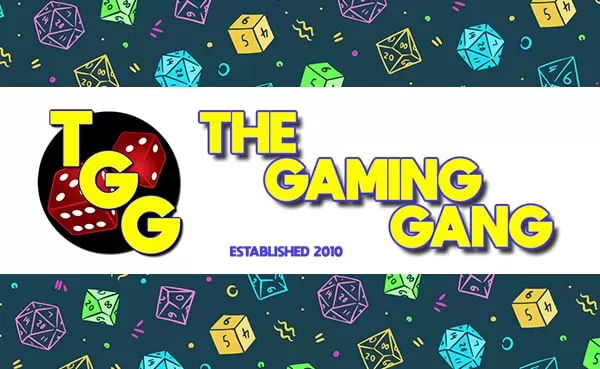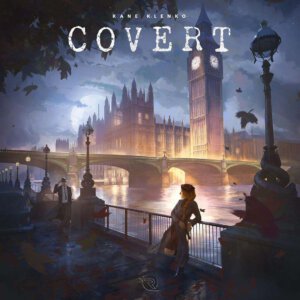Publisher: Renegade Game Studios
Designer: Kane Klenko
Artists: Hokunin and Chris Ostrowski
Year: 2016
Genre: Dice rolling, set collection game of Cold War spycraft
Players: Two to four players
Ages: 10+ (12+ in my opinion)
Playing Time: Around 45 to 60 minutes for a two player game; add around 20 minutes per additional player
MSRP: $60.00
If you watched my Origins Game Fair interview with Sara Erickson then you already know, at least to that point, I’d never played a Renegade Game Studios title. Sara was an awfully good sport about my lack of Renegade experience (it’s also a fun interview if you haven’t seen it) and provided me with a review copy of Covert which had just returned to print. If you’re not familiar with Covert, the game places up to four players into the roles of spymasters who manipulate their cadre of three agents in order to be the first to complete six missions.
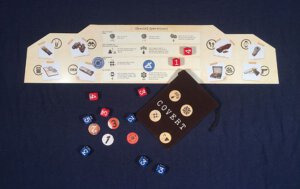
The rules clock in at ten pages including plenty of illustrations and bullet point/clarification boxes. For the most part everything is clearly laid out although, when Elliott Miller (my best friend and the man behind Voice of E) and I were learning the two player game, he and I ended up debating the meaning of a rule involved in the code breaking portion of a turn. We finally came to agreement on how it worked and I’m 99.9% sure we got it right. You can check out the rules right here.
Players will begin the game by randomly drawing a character card. This card represents their spymaster and provides each player with a unique ability. These abilities could help in code breaking, drawing special operation tokens, moving agents around the globe, and more. The inclusion of these character cards not only help a player devise a strategy for that particular play session but also provides a bit of a boost to Covert’s replayablity since clever gamers will probably tweak their approach depending on their character.
The spymasters will also draw three agency cards and place their agents in the cities shown on the cards. Then that deck is reshuffled and the players will receive two agency cards which they’ll keep hidden behind their screen. These agency cards are used to complete missions or provide a special operation. The card will show a piece of equipment, a city, and a special operation. A player may use the agency card as a required piece of equipment on a mission card, or immediately move an agent to the city on the card, or 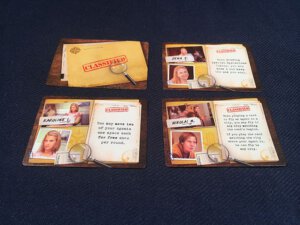
On a side note, the special operations are simply free actions or modifiers one may use at any time during their turn. There are eight special operations in all and they range from modifying a die roll, or gaining an extra cipher counter swap, or resolving a dice action before anyone else, etc. The ops are fully explained on the back of your screen as well. In fact, all agency cards may be used at any time during your dice resolution phase.
The players will then be dealt three mission cards of which they’ll get to keep two and return one to the bottom of the deck. Then three mission cards are placed face up next to the deck and these may be chosen by a dice action in the resolution phase. The mission cards display a victory point value if you complete the mission as well as a possible permanent bonus you can receive upon completing it. The main thing you’ll be looking for on these cards is the combinations of equipment icons, city names, region symbols, and/or agency card symbols. These are indicators of how to successfully complete that mission. The more that mission is worth in terms of victory points the more items you’ll see on the card.
As an example, your mission card may simply show the city names of Palermo and Milan. This means you need to have an agent in each of these cities and had placed a die onto the complete mission action circle during the earlier dice placement phase. Granted, this example is a pretty easy mission so you’d only net four VPs and a bonus of always satisfying the requirement of having the film equipment card to complete missions. The high scoring missions, up to fifteen points, will require much more than having a couple agents in two cities. Interestingly enough, the higher victory point total the mission has the more likely you won’t get a bonus for completing it.
Next up each player will receive two code cards and place them behind their screens. These cards display a three digit cipher (with a combination of the numbers one through six) on one side and a piece of equipment on the other. The combination is what you’ll be looking to manipulate the cipher counters on the decoder section of the game board to match up during the code breaking phase of the turn. If you’re able to match the combination you score that piece of equipment. The code cards are also worth two victory points at the end of the game if you never use that piece of equipment. Once everyone has their code cards, that deck is divided into two equally sized decks. When a player successfully breaks a code they draw a replacement card from either deck.
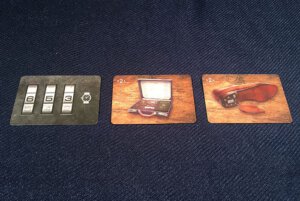
The final part of setup is simply to layout the turn order tokens somewhere within easy reach and place all the special operations counters into the drawstring bag.
At this point you may be reading this review and be thinking to yourself, “Geez Jeff you seem to be jumping all over the place so far. You’re referencing turn phases I know nothing about as you write about the cards and it’s a little confusing.” That may be but, although a good part of the game revolves around dice placement and resolving your actions from that placement, the real key to playing Covert is in the various cards and how they interact with each other in order for you to complete missions. I think it’s important to write a bit about the cards themselves before diving into the turn structure.
To begin play you’ll choose someone to be the first player and then everyone rolls their five dice out in the open. I recommend all the players agree to stop for a moment before the first player places their initial die because it’s crucial for everyone to not only see what they’ve rolled but also what their opponents have rolled as well. Plus, each spymaster has a one shot reroll token they may use at any time so you want to give all the players a chance to take advantage of that token. Once you’ve taken a few seconds to peek at all the dice, if no one wants to reroll, the first player will place their initial die. Players alternate placing a single die in any one of the available action areas until all the dice are placed and/or everyone has passed to determine the order of play for that turn.
A die may be placed in a multitude of locations across the board. Most of the time your dice will be placed in one of the four action circles across the top of the board. The circles spots wheeled around numbered one through six and the actions include moving an agent, taking an agency card, taking a mission card, or completing a mission. You’ll place your die in the spot on the circle which corresponds to the number showing on the face of the die being placed. If there’s already a die/dice on the circle, your die must also be in sequence to another die.
For example, I’m the first player and I place a die showing a six to move an agent. The next player who wants to take that action will have to place a die showing either a five or a one, otherwise they won’t be able to put a die on that circle. That player may choose to use and discard a special operation, which allows them to add/subtract a pip, to change a die to a one or a five but if they can’t perform that op they’re going to be out of luck. The player could also choose to spend their reroll token, if they still have it, since it can be used at any time. Personally, I haven’t seen anyone spend the token in this way in any of the games of Covert I’ve played so far. I really like this bit of blocking your opponent(s) although it tends to be more prevalent, and more satisfying when you pull it off, in a two player game when your opponent has no ops and already used their reroll.
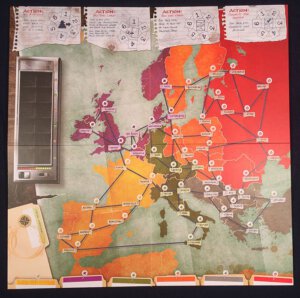
Move an agent – For each die on the circle you may move each of your agents one space.
Take an agency card – For each die you may take an agency card from the six region areas at the bottom of the board if you have an agent in that region. If you spend two dice you may choose a face up card from any region or draw one from the deck.
Take a mission card – Simply enough take either a face up mission card or draw one from the deck. You do have a hand limit of three mission cards so you’ll need to discard down to three if you go over.
Complete a mission – If you can satisfy the requirements on a mission card, place the mission card in front of you and score those juicy victory points. Any equipment or other card needed that wasn’t provided by a completed mission bonus is discarded.
There are also two actions available which have no circles where players can place any dice, regardless of the number on the faces.
Decode ciphers – Dice may be placed on the decoder. That die may be used by the player during the decoding phase to replace a number on a counter to the number on the die.
Special operations – A die placed here nets the player a token from the special operations draw bag.
One final aspect of dice placement is determining turn order. At any point during the dice placement a player may choose to pass. This means they won’t place any more dice but they gain the next available slot in the upcoming turn order so the first player to pass becomes the first to conduct their turn and so on until all the players know when they’ll get to resolve their dice.
Once the players have finished with dice placement, and have their spot in the turn order, you’ll move onto breaking codes. Beginning with the first player, you may now attempt to crack two ciphers from your code cards. Everyone will get to do this as the code breaking doesn’t require allocating any dice during the placement phase. The first player may swap two adjacent cipher counters on the decoder vertically or horizontally in an attempt to match the ciphers on their code cards. This can be done twice. One of the character’s special abilities is to gain an additional swap and there’s also a special operation to do that as well. Also, any dice a player placed on the decoder may replace a counter for the number showing on the die’s face. If you use a die in this way it returns to your pool once it’s used to replace a counter. Regardless of how many swaps take place you may only solve two code cards.
Here’s an example: Let’s say Cameron is the first player this turn and previously allocated a die showing a six to the decoder during the placement phase. He has a code card showing 436. For his first swap he’s able to maneuver the counters in one row to show 431. Obviously he’s going to use that die he placed to turn the one into a six so he’s able to crack that code and score the piece of equipment on the other side of the code card, which is also worth two VPs if he never uses that equipment. He’ll then draw a new code card to replace the one he just cracked. Now Cameron still has the chance to swap two counters and maybe crack another code. If his spymaster had the ability to gain an addition swap he 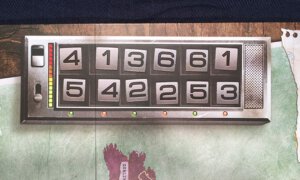
After everyone has finished breaking codes you then proceed to dice resolution. Beginning with the first player, each spymaster will resolve one of their actions. These actions may be performed in any order regardless of the order the dice were originally placed. Let’s say, as an example, I’m the first player this turn. Earlier I placed my initial die on the complete mission circle to guarantee I could take that action, my next die on the move agent circle, then a die on the agency circle, another die to the move agent circle, and finally passed on placing my fifth die in order to score the first player token.
I decide to resolve my two movement dice and move an agent one city while also entering a different region, move another agent two cities to set up completing a mission on a later turn, and decline to move my last agent. Then the rest of the players proceed, in turn order, completing an action from their dice. It’s my turn again and I decide to play an agency card which allows me to immediately jet that agent who stayed stayed put to the city named on the card. Say I already have the piece of equipment I need to complete a mission card I possess as well as now have an agent in the mission city and another in the mission region. I can now resolve my complete mission action to score those victory points and put that caper to bed. Everyone then goes around the table resolving another action and it comes back to me to use my final die to take an agency card from the region where I have an agent. Once all actions are completed and dice are back in their respective player pools (you pick up your dice as you resolve actions) we’re ready to move on to the next turn and roll those bones again. The person who went last in the turn will become the first player for the next turn and the beginning turn order proceeds from them clockwise.
A couple items of note regarding moving your agents. First off, pay special attention to the routes marked on the map. Unless you use an agency card to immediately transport an agent to a locale, you have to follow the blue lines (string) connecting the cities. Although two cities my look close together on the board you can’t travel from one to the other in a single move unless they’re connected by a line. Second, when an agent travels from location to location they leave intel behind in any city they leave. These are represented by cubes, corresponding to your player color, which are placed in the city. The first player to enter a city containing intel from opponents gets to gather those cubes. You may trade two cubes of a matching color to draw an agency card. I found this intel gathering to be a cool little twist.
A game of Covert will come to a close once any player completes a sixth mission. As soon as that takes place, everyone will finish the current turn by resolving remaining action dice (possibly completing more missions) and victory points are tallied. Total up all your completed missions and don’t forget to include two points for every unused equipment card from your code breaking. Whoever has the the highest total is the grand spymaster. In case of a tie whoever completed the most missions wins. If you still have a tie then the player who completed the highest value mission is the winner.
Now that you have a pretty good idea of how to play Covert and must be wondering what I think of the game overall. The first clue I really dig the game would be all of the text you read just to get to this point; honestly, I wouldn’t devote this much time writing about a game if I didn’t like it. Okay, that’s not completely 100% true. I have written some rather long reviews about games I disliked intensely but that’s more of an attempt to warn people off blowing their money on complete garbage.
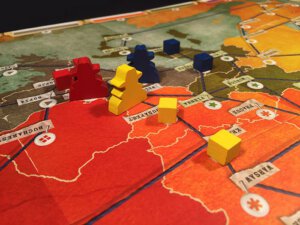
First my beef with the meeples, cubes, and map. You may recall I prefaced this at the beginning of the review. Taken individually I have no issue with the “speeples” or the board and they’re actually pretty cool; wooden cubes are wooden cubes so it’s not as if someone can really give a huge thumbs up or down to cubes. My problem arises when you’re playing the game. The board isn’t especially large and many of the cities are closely clustered together. When you have these chunky “speeples” and cubes occupying cities it can become difficult to not only see the occupied city names but other names in the area. This is especially notable when you’re playing a three or four player game and you just happen to be the player stationed at the top of the board, looking toward it upside down. If you happen to be like many gamers, you probably play most games at your dining room table and this can make the problem even worse. It gets a little frustrating having to continually climb out of your seat to try to find Skopje again or ask another player, for the third time in the last fifteen minutes, where Tirana is located. This problem isn’t game breaking by any stretch but does warrant mentioning.
As for the gameplay itself? I enjoyed it a lot and played with two, three, and four players. When I first read the rules, while hanging out with Elliott Miller in our hotel room in the early Sunday morning hours during Origins Game Fair, I wasn’t sure how the mechanics were going to mesh. Everything seemed interesting at first glance but it wasn’t until we started playing that it all began to fall into place. Sorry to say we didn’t finish that first game (since we decided it was probably a good idea to at least get three hours of sleep before driving back to Chicago that morning) but we’d each completed three of four missions by the time we wrapped it up. I thought it was interesting though soon into our drive home our usual chatter died off for a few minutes when suddenly Elliott mentioned he was thinking about the game we hadn’t finished earlier. I laughed because I was thinking about the same exact thing and we talked about how we thought the game would have finished up and different aspects of the design we liked. That’s the mark of a pretty darn good game when you’re discussing it hours later.
Thankfully I’ve since had the opportunity to play three games of Covert to completion. I’ve enjoyed each play through because the design scratches plenty of my favorite gaming itches. I always enjoy a game that makes me have to do a bit of thinking and weighing my options. It’s not as if I want to critically analyze each and every decision but I do enjoy needing to take a moment to an look for an opening to exploit or plotting a turn or two ahead. One aspect of quite a few Eurostyle titles, which leaves me cold, is the rinse and repeat style of play one normally falls into once you have a firm grasp of the game; if I go first in a turn I always place my worker here; I have this set so I always do this and so on. That game eventually becomes a bore to play. This is why you see so many Euro titles become super hot for a short period of time and then suddenly fall off the cliff in popularity. Although Covert is more of a Eurostyle design I found plenty of randomness to keep my attention, not to say after enough plays you won’t fall into a pattern playing this game.
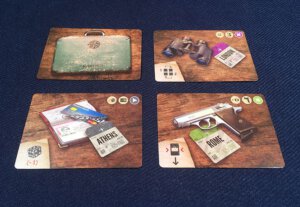
Covert is nicely themed, although you don’t really feel like you’re a grand spymaster, and the art style and graphic presentation tie together quite well. I will point out that one of the agency card layouts includes a modern style credit card and it jumps out as not fitting in. Sure, Diners Club and other cards existed in the 1960’s but looked completely different.
I will say Covert is a title which can easily lead to bouts of analysis paralysis simply because of the variety of options available during a turn. Not only will players have to determine how they want to place their dice to reserve upcoming actions but gazing at a number of cards, which end up in front of a player (with a multitude of icons, symbols, and possible uses), can lead to a bit of vapor lock. In the heat of the moment, it’s very easy to miss something beneficial on a card only to notice it after your chance to take advantage of it has passed. Also, if you play with someone who approaches say a game like Munchkin as if they were Garry Kasparov taking on Deep Blue in a chess match you might want to stick with two players or expect to devote an inordinate amount of time to Covert on the table.
In order to make playing your early games of Covert a bit easier, nip some possible frustrations in the bud, and steer the right gamer to this title allow me to share a few tidbits.
I recommend learning how to play with two people before tackling the full complement of four. The reasoning behind this is pretty simple: There’s a lot going on under the hood of this game and getting it all to click with two players is a lot easier than three or four. It isn’t as if the rules are complex but, as I mentioned above, it’s easy to look at everything in front of you and wonder what the hell your next step should be. Take your time learning to play and you’ll eventually unlock all the cool aspects of the design. I happen to be the sort of person who doesn’t worry too much how long a game takes to finish if I’m having a good time though. Although the box indicates a game time of 45-90 minutes you aren’t going to finish up your first couple of play throughs that quick. If you’re the sort of gamer who goes ballistic if the game information on the box indicates a sixty minute game and it ends up taking eighty minutes to play then Covert might not be for you.
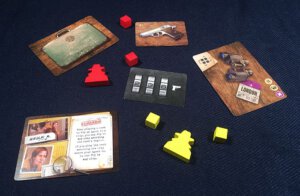
It’s also important to keep in mind this is a Eurostyle game so there isn’t much player interaction outside of trying to block the other players during the dice placement. Covert doesn’t have that puzzly, “playing in a vacuum” feel as some Euros do but you’re also not constantly impacting the other players either. This is a bit “thinky” design too so you might find a bit less conversation taking place as you play; I happen to be rather chatty when I game and did find myself doing less talking than the norm while playing. Not to say this is a bad thing by any means but something to point out for those who need to have a constant stream of banter as they play.
As for actually playing a game of Covert? Don’t be afraid to pass early in order to secure a good spot in the turn order. Depending on what you’re looking to accomplish in your turn you might want to lose out on placing your last die or two in order to go first; if you can easily decode a couple of codes cards (especially if that equipment you’ll gain is going to help you complete a mission) if you get first crack don’t let other players get in there and mess up the cipher counters you so desperately need to stay put.
Speaking of code cards, don’t suddenly fall in love with the decoder. In both games I played with more than two players, one player became fixated on the code breaking phase. Yes, it’s a fun little mini game within the game but the the meat and potatoes of Covert is completing missions. Devoting a couple of dice toward the decoder is going to hamstring you as far as moving agents, getting agency and mission cards, and completing said mission cards. All that equipment you’ll end up stockpiling isn’t going to help you much and you certainly won’t win the game popping off a max of four VPs every turn.
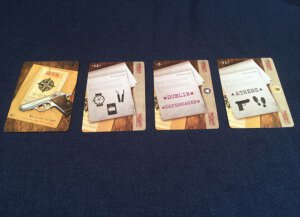
Finally, pay attention to your cards. I think this is what might trip players up the most. Sometimes they’re so focused on the dice placement, or code breaking, or an optimal path for an agent to take to get somewhere that an important aspect of a card sitting in front of the player is missed. Maybe they forget they could have used a special bonus from a completed mission card to knock out a current mission two turns ago. Or didn’t realize an agency card could transport an agent to a city right next to a mission objective. This could easily lead to irritation and no one likes to sit around being irked when they’re supposed to be enjoying something fun.
I’ve really dig Covert, and the design is right up my alley, so don’t take any of the above observations as big knocks but me just making sure folks understand if this will be the right game for them. If you’re a regular visitor and my observations usually click with your opinions then Covert is a must buy. If this is the first TGG review you’ve run across then rest assured I’m certain a lot of gamers will enjoy Covert and welcome the title into their collections.
